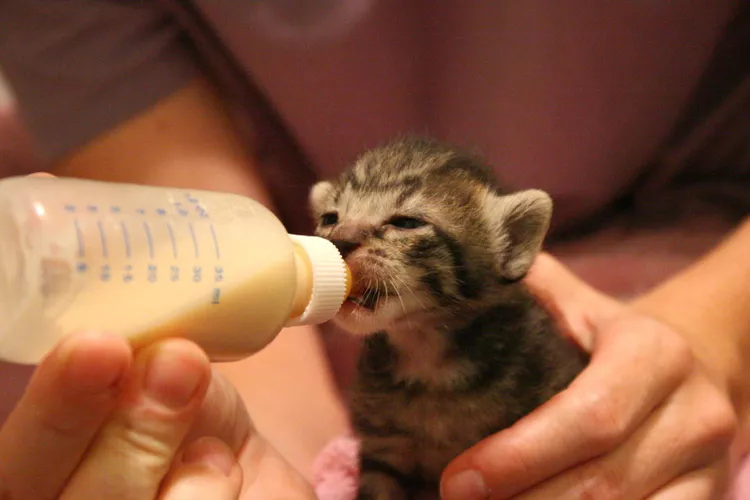How to Bottle Feed Your Newborn Kittens

To ensure the survival of a newborn kitten, ample nutrition must be provided. Sometimes, however, the mother cat grows ill and cannot nurse her young or she alienates a kitten from the litter due to an injury or disability. In these situations, you will need to step in and take on the role of the mother cat. This often requires bottle feeding a newborn kitten until the kitten is strong enough to eat regular cat food.
Preparing to Bottle Feed Your Kitten
Depending on its size and condition, your newborn kitten will need approximately nine to 12 daily feedings. For the first two weeks of life, you will need to count on feeding the kitten every two hours during the day and every four hours overnight.
In order to bottle feed the kitten, you will need to gather a few supplies. Regular human baby bottles will likely be too big, but most pet stores have newborn kitten bottles and nipples, as well as a commercial formula specifically designed for kittens. If your kitten is a preemie, you will need to dropper-feed it until it's strong enough to suck on the bottle. Make sure to check with your veterinarian if this is the case.
What You Need
- Newborn kitten bottles and nipples
- Dropper (if needed)
- Kitten formula
- Soft towels and washcloths
- Kitchen scale
Prepare the Formula
Just as with human babies, it's important that you feed your kitten with sterilized bottles and warm the formula before offering it to the kitten. Taking a few minutes to prepare everything properly will make each meal go a little smoother.
- Sterilize the baby bottles and nipples in a boiling water bath for about five minutes. Allow them to drain on a clean towel before using.
- If you are using a new nipple, you will need to make a small hole in the tip. Make sure to keep the opening small so the formula does not come out too fast. You can use a pair of cuticle scissors to cut the tip off the nipple. When held upside down, the formula should drip out.
- Place a large towel, a washcloth, and a bowl of warm water on a table next to a comfortable chair.
- Mix and fill one bottle with kitten formula according to the directions on the package.
- Warm the formula by placing the bottle in the bowl of hot water.
- Test the temperature by dripping a few drops on your forearm. If it burns, it's too hot; body temperature is just right.
Bottle Feed the Kitten
Sit in the chair with a towel folded in your lap. Place the kitten face down on your lap. You can wrap it in the towel to make sure the kitten stays warm while it eats.
Without raising the kitten's head, place the nipple in its mouth. The kitten should instinctively start sucking right away. Continue to feed the kitten until it pulls away.
Burp the Kitten
Much like human babies, kittens need to be burped after nursing. The best way to accomplish this is to hold one hand under the kitten's abdomen and gently pat its upper back. But do so gently—you don't want the kitten to vomit. If it doesn't burp right away, don't worry, just move onto the next step.
Stimulate Elimination
The mother cat stimulates her kittens' elimination by licking their anuses and genital area with her rough tongue. You can imitate this process by placing a warm, damp washcloth in the same general region, wiping softly. Be careful not to wipe too vigorously as this can cause irritation to the sensitive skin in that area. It may take a couple of feedings to see results, so don't despair. Urination may take even longer.
Let the Kitten Sleep
After nursing, your kitten will most likely fall asleep. Place it in a warm cat bed and let the kitten sleep undisturbed.